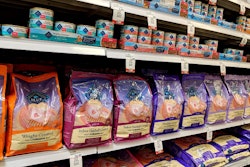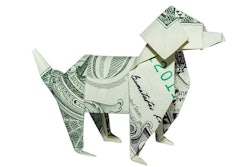
U.S. consumer pet food spending reached US$28.85 billion in 2018, a -7.3% decrease from 2017, according to recently released data from the U.S. Bureau of Labor Statistics (BLS) Consumer Expenditure Surveys, analyzed by John Gibbons of PetBusinessProfessor.com.
Keep in mind that this consumer spending data doesn’t always match up exactly with retail sales or even spending data from other sources. For example, the American Pet Products Association’s (APPA) annual spending report, released in March 2019 during Global Pet Expo, showed U.S. pet food spending for 2018 at US$30.32 billion, a 4.3% increase. The difference likely lies in timing as well as data sources and collection methods. APPA doesn’t provide much information on theirs. As for the U.S. government, its data was “gathered by the U.S. Census Bureau from over 42,000 interviews and spending diaries,” Gibbons wrote; then it was compiled and published by BLS.
You may still choose to use the more positive APPA pet food report, but the BLS data is worth a look and an attempt to understand the market forces that may be driving the drop in spending shown.
Effects of superpremium pet food’s wide availability
First, Gibbons proposed that the ongoing trend of superpremium pet foods, which naturally cost more, “magnifies the results of any changes in consumer purchasing behavior.” Thus, the four largest differences in pet food spending, whether up or down, have all happened in the last four years, leading to the - US$2.27 billion decline in 2018, the second largest in the history of this spending being tracked. (The largest was a US$2.99 billion decrease, or 10%, in 2016.)
Of course, the superpremium trend is more of an enduring, umbrella one. Underneath are all sorts of smaller, short-term trends, which Gibbons postulated have historically driven the pet food market. “A new food trend catches the consumer’s attention and grows … for two years,” he wrote. “Then sales plateau or even drop … and we’re on to the next ‘must have.’”
That helped create a pattern of pet food spending in the U.S. of a two-year increase, followed by a year of a plateau or decline. This pattern played out, Gibbons’ analysis has shown, from 1997 to 2017 with one exception before now: 2006-10, a period including the 2007 melamine-related pet food recalls and the Great Recession.
So, what’s breaking up the pattern now? “In 2017, according to the 20-year pattern, we should have been beginning a new trend,” Gibbons wrote. “There was the expected lift in pet food spending, but what was the new ‘must have’ type? There were some possible candidates, but nothing stood out.
“A deeper dive into the data showed that the US$4 billion increase in pet food spending in 2017 didn’t come from a new trend,” he continued. “It came from a deeper demographic penetration of superpremium foods. Value shopping in a highly competitive market, especially on the internet, had made superpremium pet foods more accessible to a broad swath of consumers.”
I would add that superpremium products aren’t just more widely available on the internet; they are also now seen in many food, drug and mass (FDM) retail outlets.
Younger pet food consumers offer positive outlook
Gibbons’ analysis includes other contributing factors, such as deflation and the Food and Drug Administration investigation into a possible link between grain-free pet foods and recent cases of canine dilated cardiomyopathy. But it’s not all gloom and doom for the industry: one bright spot comes courtesy of younger pet owners.
A breakdown of the BLS data showed 2018 pet food spending growth of U.S. Gen Z pet owners soared over 80%, though they still make up a small portion of pet food consumers – just US$1.12 billion of the total US$28.85 billion in spending, or 4%. But their numbers are growing, with Gen Z consumer units (similar to households) increasing by 6.6% as they moved out of their parents’ households and, as Gibbons put it, took their pets with them.
While millennials’ pet food spending rose a more modest 5.5%, up to US$3.82 billion, that increase may offer even more positives. According to Gibbons, their recent spending pattern has “foreshadowed the overall market for the following year.” For example, it indicated that millennials were the first to buy in on the trend of superpremium pet food being available at value prices.
As Gibbons said, let’s hope their spending increase for 2018 means overall pet food spending will be up for 2019.

















